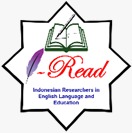Multimodal Discourse Analysis on Mathematics Instruction: A Case Study in Indonesian Primary School
DOI:
https://doi.org/10.22219/englie.v3i2.22484Keywords:
multimodal texts, causal explanation, mathematics instructionAbstract
Mathematics has been taken into account as one of the prominent subjects in various levels of formal education. The most common issues related to learning mathematics are more likely perceived by students in primary schools as they begin to develop their critical literacy skills, including mathematics register, calculation, concepts, and principles. Therefore, this research aimed at (1) identifying types of multimodal texts used for mathematics instruction and (2) knowing how semiotic resources create meaning in terms of the mathematical concept. The research setting was SDN 08 Sei Wain, Balikpapan Utara, East Kalimantan participated by the fifth-grade students. The data collection procedure included observation and questionnaires, while data analysis was derived qualitatively. The result of the research was expected to be an insightful reference for primary teachers, policymakers, and stakeholders to improve the quality of learning in primary education.
Downloads
References
Anderson-Pence, K.L., (2017). Techno-Mathematical Discourse: A conceptual Framework for Analyzing Classroom Discussion. Education Science Review.
Bateman, J. (2008). Multimodal Documents and Genre. In J. Bateman, Multimodality and Genre: A Foundation for the Systematic Analysis of Multimodal Documents.
Bazerman, C. (1998). Emerging Perspectives on the many dimensions of scientific discourse. In Reading Science Critical Functional Perspectives on Discourses of Sciences (pp. 16-28). New York: Roudledge.
Chan, B. J, Yeh, L. W., & Chen, H. L. (2012). Applying illustration and layout design for textbook to enhance the art of teaching: A case of social studies textbook. Journal of Textbook Research, 5(1), 47-84. http:/ej.naer. edu. tw/JTR/v05.1/2012-04-jtr-v5n1-047.pdf
Cope & Kalanzis. (2009). “Multiliteracies”: New Literacies, New Learning. Pedagogies: An International Journal (4: 164–195). Routledge.
Dornyei, Z. (2007). Research Method in Applied Linguistics. New York: Oxford. ETS. (2011). The praxies Series. Retrieved June 15, 2012, from Middle School Mathematics: http://www.ets.org/media/tests/PRAXIS
Freadman, A. (1996). Peirce’s second classification of signs. In V. Colapietro & T. Olshewsky (Eds.), Peirce’s doctrine of signs: theory, applications, and connections(pp. 143-160). Berlin, New York: Mouton de Gruyter.
Gee, J.P. (2003). What video games have to teach us about learning and literacy. New York: Palgrave Macmillan.
Goodman, S., & Graddol, D. (1996). Visual English. In S. Goodman, & D. Graddol (Eds.), Redesigning English: New Texts, New Identities. New York: Routledge.
Gutwinski, W. (1976). Cohesion in Literary Texts: A Study os some Grammatical and Lexical Features of English Discourse. The Hague: Mouton.
Halliday, M., & Martin, J. (1994). Writing Science. Pittsburgh: University of Pittsburgh Press.
Jewitt, C. (2005). Multimodality, “Reading” and “Writing” for the 21st Century. Discourse: Studies in Cultural politics of Education. New York: Routledge.
Kern, R., (2008). Literacy, Technology, and Language Learning: Where we’ve been and where we’re deaded. Retrieved fromm php.csumb.ede.
Kress, G, & T. van Leeuwen, (2006). Reading Images: The grammar of visual design (2nd Eds). London: Routledge.
Lemke, J. (1998). Multiplying Meaning Visual and Verbal Semiotics in Scientific Text. In J. Martin, & R. Veel (Eds.), Reading Science Critical and functional Perspectives on Discourses of Science (pp. 88-113). New York.
Martin, J. R. (1992). English Text: System and Structure. Amsterdam: Benjamins.
Martin, J. R. (2002). Meaning Beyond the Clause: SFL Perspectives. New York: Cambridge University Press.
Mohan, B. & Slater, T. (2005) A functional perspective on the critical ‘theory/practice’ relation in teaching language and science, Linguistics and Education: An International Research Journal, 16(2), 151- 172..
Nordin, A. (2005). Students' Perception on Teaching and Learning Mathematics in English. Universiti Teknologi Malaysia.
Raiker, A. (1992). Spoken Language and Mathematics. Cambridge Journal of Education, 32 (1).
Reeves, C. (2005). The Language of Science. New York: Routledge.
Stringer, E. (2004). Action Research in Education. Ohio: Pearson Education.
Thomas, H. (2009). Reform-oriented Mathematics in Three 6th Grade Classes: How Teachers Draw in ELLs to Academic Discourse. Journal of Language, Identity and Education, 8 (2/3), 88-106.
Veel, R. (1997). Learning how to mean - scientifically speaking: apprenticeship into scientific discourse in the secondary school. In F. Christie, & J. Martin, Genre and Institutions (pp. 171-172). London: Cassell.
Weninger, C. (2018). Textbook analysis. In C. A. Chapelle, (Ed.) The encyclopaedia of applied linguistics. Willey and Sons.
Downloads
Published
How to Cite
Issue
Section
License
Copyright (c) 2022 Healty Susantiningdyah, Ulfa Kurnia, Winarni Winarni, Alfi Suci Dirgantari

This work is licensed under a Creative Commons Attribution-ShareAlike 4.0 International License.
Authors who publish with English Learning Innovation (englie) agree to the following terms:
- For all articles published in English Learning Innovation (englie), copyright is retained by the authors. Authors give permission to the publisher to announce the work with conditions. When the manuscript is accepted for publication, the authors agree to automatic transfer of the publishing right to the publisher.
- Authors retain copyright and grant the journal right of first publication with the work simultaneously licensed under a Creative Commons Attribution-ShareAlike 4.0 International License that allows others to share the work with an acknowledgement of the work's authorship and initial publication in this journal.
- Authors are able to enter into separate, additional contractual arrangements for the non-exclusive distribution of the journal's published version of the work (e.g., post it to an institutional repository or publish it in a book), with an acknowledgment of its initial publication in this journal.
- Authors are permitted and encouraged to post their work online (e.g., in institutional repositories or on their website) prior to and during the submission process, as it can lead to productive exchanges, as well as earlier and greater citation of published work (See The Effect of Open Access).
This work is licensed under a Creative Commons Attribution-ShareAlike 4.0 International License.
















1.png)












